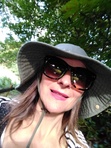My Diabetes Avoidance Blog – On Writing
Hello dear readers,
I’ve taken a break from this blog, as I’ve been working on my MA and honing my short story writing skills. The past two years, I’ve entered more creative writing competitions than ever. I’ve received some very positive comments about my short stories, and I’ve gained confidence since I became a contributing editor for a journal. The advice you get about revising and re-writing is really very true. When you keep re-crafting your stories, it is really surprising how great they can become.
As a writer, I know how long writers spend simply coming up with an idea and setting it down on paper. It is daunting to rewrite when a story isn’t working, especially when there is no guarantee of publication. I know how much dedication and commitment this requires.
Yesterday, I sat down to rewrite a story which wasn’t going in the direction I had envisioned. When I allowed it to move naturally in the direction it seemed to be moving in, it improved dramatically. The character had taken over and was pushing the story in a particular direction. When I got out of the way, and allowed the story to progress naturally, the story improved and began to sound more genuine.
As a reader of creative submissions for a journal, I often find that what is hampering a story is a sudden authorial intervention which takes me out of the story (interferes with my suspension of disbelief), often with some sort of clever interference, and once the natural rhythm, the author has created, is interfered with, it is impossible to get back into the story.
Many books of advice for writers do not mention rhythm, perhaps because this is difficult to isolate. Aristotle’s focus was on plot and the action that moves the story along, as well as Katharsis – the how are you? – mysterious action ‘how do you fare?’ of storytelling; something that keeps us reading and has only recently been realised by people who are using creative writing as a tool to overcome trauma. I am very interested in this aspect of the process of storytelling, but it is a complex process which requires distance and empathy. Ernest Hemingway used to write a paragraph a day at a coffee shop. Most of us ought to be able to fit this pattern into our daily schedule. When you go back to this writing it can be surprising to find you have written some real gems.
Once you have mastered these important layers, and you find something is missing, what else is there that needs work?
A good practice is to leave your work for a few days or a week and go back to it. It is easier to hear the story when you do this. Another suggestion is to ask someone to read your work back to you aloud. This is not so that you can revel in the glory of being an author, but is a device to help you hear your work. This is a practice I have always followed. Because of this, I have several stories that have never seen the light of day. I know instinctively they are not quite right. I am keeping them for an inspirational moment when I can re-craft them.
As an author, it is important to recognise that sometimes a story won’t work until it’s ready. For example, I had written my short story ‘Black Ink and Anxiety’ and didn’t have an ending. I knew it was a good story but I had to wait until the ending came to me. A month later, I was on Twitter and noticed a painting published with Open Journal of Arts and Letters. I liked it so much, that I got into a conversation with a friend on Twitter about it. She asked me whether I could see the birds. At that time, I couldn’t. The painting just looked like a mass of pleasant lines and colours. I’d been stuck indoors for a week and hadn’t taken the time to look at nature or birds. This was unusual for me. I’d been writing a play about consciousness. I don’t want to give away my idea here because I’ve entered the play into a competition. But it involves language and what is in our consciousness. Because I had been thinking about this subject a great deal, I realised that what my friend Rowena had seen in the picture might not be visible to me because the birds were not in my conscious awareness. I went outside and looked at birds and return to the painting. At last I could see the bird. I now had the ending to my story because the picture had a question with it. Can you write a story about this painting? I asked for permission to link to the painting and finished the story.
I submitted my story to O:JA&L. It was accepted and published in January this year.
You can read it here:
Prose Discourse: Short Story|Hermione Laake|”Black Ink and Anxiety”
***
This blog was supposed to be about how I succumbed to two bars of chocolate this week, after giving up my usual daily walk to town for coffee and self-isolating instead. As you can see, my writerly pen had other ideas.
With love,
Hermione
Thoughts
- Hermione Laake's profile
- 23 followers



